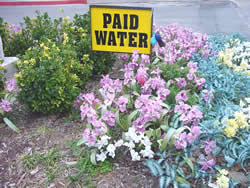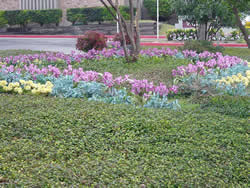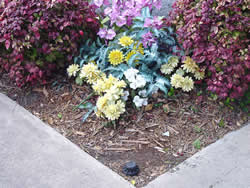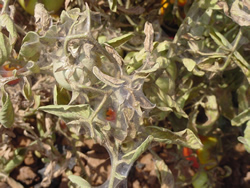Search
For The Answer
Click here to access our database of
Plant Answers
Search
For The Picture
Click here to access the Google database of plants
and insects
Information
Index
Alphabetical Listing of Topics, Recommendations
and Plants
Milberger's Nursery and Landscaping
3920 North Loop 1604 E.
San Antonio, TX 78247
210.497.3760
nursery@milbergersa.com
Open 9 to 6 Mon. through Sat.
and 10 to 5 on Sun.

Three exits east of 281, inside of 1604
Next to the Diamond Shamrock station
Please click map for more detailed map and driving directions.


WATERING, LAWN CARE,
MANAGEMENT OF NEWLY ESTABLISHED PLANTS, VEGETABLE GARDENING, ROSE, CRAPE
MYRTLE AND VITEX CARE DURING HOT, DRY GROWING CONDITIONS
this Have you noticed that it has been hot and dry lately? If you haven't and have not been watering your plants, I imagine that your place resembles the Mohave Desert. Has your water bill reached astronomical proportions? Maybe an evaluation of your watering methods of different plant materials will result in more efficient use of the available water and at the same time reduce the amount you are using.
GENERAL WATERING RECOMMENDATIONS First check your methods of application. There is no use in applying water any faster than the soil will soak it up. If applied faster than this, the surplus will either run down the curb into the street or else flood out your neighbor. Sandy type soils will usually take water almost as fast as it can be applied but tight, clay soils will take it up very slowly. Select the method of application that best fits your soil. Drip irrigation systems for shrubs makes the most efficient use of water for beds. Secondly, use a mulch wherever possible. A good mulch conserves moisture, prevents compaction, keeps soil temperature lower, reduces week population and in case weeds do get a start, they are much easier to pull if a mulch has been used. Check the depth of the mulch material. Organic mulches tend to decompose or sometimes wash away, so frequent checks and replacement where necessary will help conserve moisture. While night-time watering is conducive to development of plant diseases in some environmental conditions, one does get more efficient use of the water in the early morning and late evening when evaporation rates are lowest. Also, as hot as it is during the night in the summer months, watering at night will not be a significant factor in disease development. These best time to water in the summer is after 8 p.m. and before 10 a.m. If you don't have an automatic watering system, invest in water timers (the Gilmour Mechanical Timer sells in the $10-$12 range) which you can activate when you go to bed and allow the sprinklers to water an area for two hours per setting. Be careful to adjust the spray pattern so it doesn't water the street! Since we are not functioning under severe water restrictions, you can do this every night -- depending on how many hoses and sprinklers you have - until the entire yard is watered. Last, but by no means least, is the practice of doing a thorough job of watering each time it becomes necessary to irrigate. A thorough watering at 7- to 10-day intervals encourages deep root penetration and full utilization of the available soil moisture. Just because plants happen to wilt during the heat of the day doesn't mean the soil is dry. If the plants are still wilted the following morning, water that area the next night.
======================================================= LAWN WATERING AND CARE A homeowner who wants to insure that the lawn grass survives must have at least a basic knowledge of the important factors that influence plant-water relations - then a good irrigation plan can be developed based on sound principles. Water management can be visualized as a bank checking account with additions (inputs) such as precipitation, irrigation, dew; losses (outputs) such as evaporation, transpiration, runoff, leaching beyond the root system, water used in the plant for growth and processes; and a reserve balance such as soil texture, plant root depth at any point. The maximum reserve pool of plant-available moisture depends primarily on soil depth and texture as well as the extent of the plant's root system. Thus, unlike a checking account which can hold unlimited funds, the "reserve water account" has a maximum limit determined by soil and plant factors. A plant with a l2-inch root system has twice as much water available to it compared to one with a 6-inch root system. Major factors that limit rooting are: close mowing; excessive nitrogen, irrigating lightly and frequently, compacted soils, and root feeding insects. In a home lawn situation management practices have a profound
influence on how often irrigation is needed because they affect
the growth and development of the plant. A. Mowing Height - mowing too close for the species will result in a much reduced root system and an open turf. The reduced rooting decreases the "maximum reserve pool of water" while the open turf results in higher evaporation versus transpiration losses. The proper height to mow St. Augustine is 3 inches or the highest setting that the lawnmower allows. B. Excessive Nitrogen - applying nitrogen beyond the plant's
needs will cause a decline in rooting and promote excessive leaf
growth - more leaves for transpirational losses. This results
in transpirational water use beyond the real needs of the plant.
In fact, don't fertilize during periods of no rainfall. Generally,
fertilization once in the spring (after mowing the major grass
species present at least twice) By observing indicator spots that first exhibit wilting - as evidenced by a bluish-green color; foot printing; or rolling, folding,, drooping of leaves, a homeowner can obtain some guidance as to when to irrigate his site. Water "hot spots" or those areas of shallow soil which dry faster than the rest of the lawn by using a water targeting sprinkler. The best for watering those narrow areas along sidewalks or driveways is the green Sprinkler-Soaker Hose (Gilmour is most common brand) on which a low flow rate can be adjusted with the sprinkler side facing upward and then the hose can be flipped to provide a slow soaking without runoff waste. Beware of the black, recycled rubber soaker or sweat hoses-they are soon clogged with the calcium in our hard water and get brittle in direct sun-making them useless. Don't water more than you need to but certainly irrigate enough to keep your lawn alive. The lawn may not look lush and green during the summer but if it survives until the fall rains come, you will not lose your entire lawn or have to replace the major portion of the grass. Think survival and maintenance- NOT golf course beauty. ====================================================
WATERING OF NEWLY ESTABLISHED PLANTS One of the most efficient uses of a valuable resource such as water is to insure the survival of previously purchased plants. Summer is a critical period for recently planted shade and ornamental trees. Not yet completely recovered from the effects of transplanting, they often need special care to withstand adverse weather conditions. This is why major plantings should be done in the fall, winter and spring-so the largest possible rootsystem can be developed before environmental stresses have to be dealt with. It is wise to water at regular intervals, all trees planted within the past year. If the soil is sandy, water about once a week; if it is clay or loam, thorough watering every ten days of two weeks should suffice. Using an open-end hose, regulate the water flow so there is
no run-off and let it run until the soil around the tree is saturated.
If the tree or shrub has been planted for less than a year, put
the hose end at the base of the plant so that the root-ball can
be watered. It takes several years for roots to expand into the
surrounding soil well enough to endure a severe moisture deficiency.
Until that occurs, you HAVE TO keep the original root-ball moist
or the newly planted trees and shrubs will severely defoliate
or, worse, DIE! VEGETABLE GARDENING IN THE SUMMER Vegetable plant demise in July is attributable to natural Texas catastrophes such as spider mites, squash bugs and temperatures over 90 degrees F. Vacations can also share the blame for the demise of many Texas gardens. It is amazing how fast gardens decline without water and pest control! For information about what to do at this time of the year, see: http://www.plantanswers.com/garden_column/july02/4.htm One week on vacation and encroaching bermudagrass shifts into a supernatural growth rate adequate to founder a herd of goats. Such invasions may not be of immediate concern, but fall garden preparation will necessitate detonation expertise to rid the area of the tenacious bermudagrass. To see how to handle these grass invasions into the fall-garden site to be, see: http://www.plantanswers.com/friendly_plant_killer.htm
http://www.plantanswers.com/garden_column/july02/3.htm ================================================== SUMMER ROSE, CRAPE MYRTLE AND VITEX CARE Roses also need special care during hot weather. Summer weather will cause many area gardeners to lose interest in their roses, since summer heat promotes small, faded flowers of poor quality. However, if gardeners are persistent, proper care during July and August will insure attractive foliage and an abundance of flowers throughout the fall and early winter. Poor cultural practices and neglect during summer months will weaken plants. Here are some suggestions on summer care of roses: 1. As flowers fade and petals fall, remove old flowers. Otherwise, food and energy will go into seed production rather than plant growth and flower production. 2. When removing spent flowers, cut just above the second five-leaflet leaf above the main cane or branch. 3. During hot, dry weather, water rose beds thoroughly every week to a depth of 8-10 inches. 4. Control blackspot, mildew, spidermites and foliage-eating insects by spraying with Ortho Orthenex as needed.
Another beautiful bloomer which needs your attention at this time of the year is the crape myrtle. To insure optimum growth and continuous bloom, a few steps must be taken. First of all, mulch the plant with 3-4 inches of pine bark or any other organic material. Do NOT pile mulch against the main trunk! Mulching helps keep down weeds, keep the moisture level constant, cool the hot summer soil and cut down on watering needs. Secondly, remove seed pods. The crape myrtle will bloom continuously for 100 days. Even this time period can be extended if the old flower stalks are cut off and not allowed to produce mature seeds. The 'Texas Lilac' vitex should also be managed like this. See: http://www.plantanswers.com/vitex.htm |





